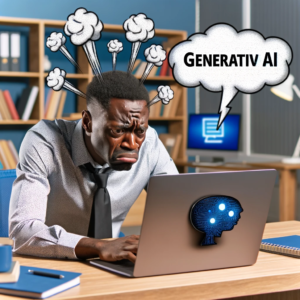Volgende week vindt in Berlijn de Online Educa plaats. Generatieve AI is daar een belangrijk thema. Ik verzorg daar een presentatie met als titel. ChatGPT: Curse and/or Blessing for Education and Learning & Development? De organisatie heeft mij gevraagd om in een online artikel in te gaan om dit onderwerp. Hieronder vind je dat artikel ook.
ChatGPT: Curse and/or Blessing for Education and Learning & Development?
ChatGPT (and other generative AI-applications) has different opportunities and challenges for education, and learning and development. In this article, Wilfred Rubens describes opportunities to reduce the workload of ‘learning professionals’ and opportunities to use ChatGPT to foster education, training, and learning. However, applications like ChatGPT also present different challenges. At the next Online Educa in Berlin, Wilfred will give a presentation on this topic.

The work of learning professionals is compelling but also demanding. Many learning professionals experience a heavy workload. They spend a lot of time and effort in the preparation, execution, and completion of the facilitation of learning. In addition, learning professionals deal with administration, innovation, communication, professional development, coaching colleagues, and participation in meetings. Amid these multifaceted tasks and responsibilities, ChatGPT emerges as a personal assistant from two perspectives.
Firstly, ChatGPT can reduce the workload of learning professionals. It supports different kinds of tasks: text-related tasks, organizational tasks, learning tasks, and creative tasks. If used thoughtfully, ChatGPT has the potential of “cognitive offloading” (Sparrow, 2022). It may support learning professionals in creating engaging lesson plans, drafting announcements, writing emails, and so on, in less time. For instance, learning professionals can leverage ChatGPT to automatically generate notices or instructional texts, which can then be fine-tuned to ensure alignment with the educational goals and the linguistic competency of the target audience. In addition, this enables the dissemination of information in a more inclusive and comprehensible way. This not only alleviates the workload of educators but also enhances the learning experience for students.
Secondly, ChatGPT supports the facilitation of education, training, and learning. ChatGPT can foster several evidence-informed instructional principles (see, for example, Surma et al., 2019). Three examples are:
- Testing as a strategy for learning and practice. Tests are valuable learning activities. Through tests, you can have knowledge processed and find out if learners have understood instructions. Learning professionals can use ChatGPT to develop assessments that accurately gauge learners’ comprehension. They can input the core concepts or skills to be tested and help in creating a draft of the assessment, including questions, answer options, and feedback, saving precious time which can be reallocated to more interactive and personalized student engagement.
- Providing feedback. Feedback is a powerful strategy to enhance learning, providing learners with information on their current standing and guidance towards achieving learning goals. ChatGPT can be used to give feedback on learners’ work. Educators can input the assignment and the learner’s work into ChatGPT, ask for feedback on content and argumentation, and then edit and personalize the generated feedback. Additionally, learners can request feedback on their own texts from ChatGPT. When it comes to using AI feedback in peer-review of research papers, researchers Zou and Schintler conclude that the overlap between human and AI feedback is “similar,” especially for papers not yet mature for publication (Coffey, 2023).
- Informal learning. Learners can be stimulated to use ChatGPT for their own learning, without being organized by a school or employer. For example, for generating ideas, such as coming up with activities for activating prior knowledge or for using ChatGPT for role-playing challenging conversations. Professor Dr. Helen Crompton, for example, encourages her learners to use ChatGPT as a subject-matter expert who discusses relevant issues with the learners. According to Crompton, “exploring information in a conversational setting helps students understand their material with added nuance and new perspectives” (OpenAI, 2023).
Despite ChatGPT’s impressive capabilities, there are limitations and risks to consider when using it. Two of these challenges are:
- The information generated by ChatGPT is not always accurate or complete because the information generated is based on the data in the training database sourced from the Internet. This means that users should critically evaluate the bot’s answers and not blindly trust it. ChatGPT’s output is primarily a “semi-product” to be further completed based on subject matter expertise.
- ChatGPT is vulnerable to bias, as the underlying data may contain biases. For example: if you ask for a profile of an organizational leader, then there is a good chance that ChatGPT’s output refers to a male.
These challenges underline the need to invest in the development of a new kind of digital literacy: being aware of how generative AI works, being aware of the limitations, knowing how to use effective prompts, and using strategies in checking the output efficiently.
In my upcoming presentation at the Online Educa, I will delve deeper into the possibilities and limitations of integrating ChatGPT in the educational and L&D realm, aiming to provide a balanced perspective on its utility and exploring whether it’s a curse or a blessing in the modern learning ecosystem. Save the date: Friday, November 24, 2023, 12:00 – 13:30. https://oeb.global/programme/agenda/oeb-23/sessions/37352
This article is partly based on Rubens, 2023. Furthermore, I generated output by ChatGPT which I edited, integrated with my own texts, and completed. Finally I asked ChatGPT to check the spelling of the text.
Deze pagina bevat al mijn bijdragen over (generatieve) artificiële intelligentie, zoals ChatGPT.
Resources
Coffey, L. (2023). AI and Peer Review: Enemies or Allies? https://www.insidehighered.com/news/tech-innovation/artificial-intelligence/2023/10/24/ai-can-lessen-peer-review-woes-researchers
OpenAI (2023). Teaching with AI. https://openai.com/blog/teaching-with-ai
Rubens, W. (2023). De invloed van ChatGPT op leren, opleiden en onderwijs (pdf). In: Tijdschrift voor Ontwikkeling in Organisaties, 13, 3, 10-16.
Sparrow, J. (2022). ‘Full-on robot writing’: The artificial intelligence challenge facing universities. https://www.theguardian.com/australia-news/2022/nov/19/full-on-robot-writing-the-artificial-intelligence-challenge-facing-universities
Surma, T., Vanhoyweghen, K., Sluijsmans, D., Camp, G., Muijs, D., & Kirschner, P. A. (2019). WIJZE LESSEN: Twaalf bouwstenen voor effectieve didactiek. Meppel: Ten Brink.
Webb, A. (2023). Amy Webb Launches 2023 Emerging Tech Trend Report | SXSW 2023. https://youtu.be/vMUpzxZB3-Y
This content is published under the Attribution 3.0 Unported license.
Geef een reactie